| |

 |
| |
|

Luras

The
author

The
works

The
collection

Techniques

Cork

Newspapers

Guest
Book



|
The origins
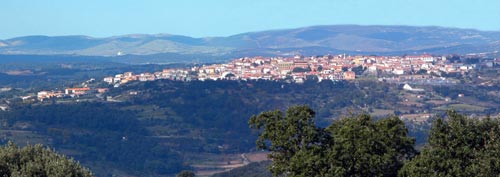 Luras
is a small town in Gallura with 2800 inhabitants. It is located in northeastern
Sardinia, extends upon a granitic hillock of the plateau of Mount Limbara,
at the height of 508 (512) metres. Luras
is a small town in Gallura with 2800 inhabitants. It is located in northeastern
Sardinia, extends upon a granitic hillock of the plateau of Mount Limbara,
at the height of 508 (512) metres.
Long ago, its name was Villa Lauras or Oppidum Luris, whose origin is
often attributed to the Latin words lura (leather bag) or laurus (laurel).
Concerning the origins of the town, there are a few hypotheses that,
according to several historians, consider it as one of the five settlements
founded by Etrurians in Sardinia around 862 b. C. Others are more inclined
to believe that Luras could have been a colony founded by some of those
Jews, 4000 in all, who had been banished and sent to Sardinia by the
Roman Emperor Tiberius in 19 a. D. This hypothesis is strengthened by
several usage and costumes of Luras’ inhabitants, by their trading
attitude, some typical local dishes and even some of their character
features.
|
| |
The
history
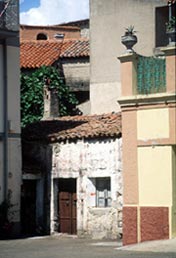 The
first document where Luras is mentioned is the “Carta Pisana”,
dated 1300, where all the “ville” (villages) of the “Giudicato”
of Gallura are divided in “Curatorie”. Luras was part of the
“Curatoria” of “Gemini Josso”. In that period
and during the Aragonese occupation, in Luras territory new villages sprang
up, which were later abandoned in different times, owing to pestilences,
famines and barbaric invasions. The
first document where Luras is mentioned is the “Carta Pisana”,
dated 1300, where all the “ville” (villages) of the “Giudicato”
of Gallura are divided in “Curatorie”. Luras was part of the
“Curatoria” of “Gemini Josso”. In that period
and during the Aragonese occupation, in Luras territory new villages sprang
up, which were later abandoned in different times, owing to pestilences,
famines and barbaric invasions.
Siffilionis (today called Silonis) lay nearby the ancient church of San
Pietro, parish of this village; Canahim or Canahini (the modern Canaili)
was placed around the church of San Michele; moreover, in the area now
called Carana, another village lay, whose name was Canarhan and belonged
to the parish of San Nicola and San Bartolomeo church.
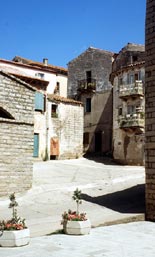 Furthermore, still in the “Curatoria” of Canahini, other villages
were located, such as Astaina and Hagiana, whereas in the “Curatoria”
of Gemini there was another village, called “Campo de Vigne”
or “de Vinyes”, whose translation might be Field of Vineyards.
Furthermore, still in the “Curatoria” of Canahini, other villages
were located, such as Astaina and Hagiana, whereas in the “Curatoria”
of Gemini there was another village, called “Campo de Vigne”
or “de Vinyes”, whose translation might be Field of Vineyards.
Later on, Luras was part of the “Marchesato” of Gallura up
to 1839.
During the 19th century, besides the traditional agricultural activities,
still practised nowadays, new trading activities throve and Luresi (Luras’
inhabitants) began to leave their village and travel throughout the island,
and not only, to sell their handcrafted articles: berrittas (ancient hats
of the male costume), wool, leather, cork and iron made articles, cloth,
wine, “acquavite” (kind of brandy), cheese, cereals etc..
This new business granted them a particular wellbeing.
Nowadays, Luras’ economy is based upon farming, breeding, wine-growing,
cork working and granite quarrying. The vineyards lying in this territory
are the widest in upper Gallura and maybe the best cultivated too, and
their wines are highly valued even beyond the regional and national borders;
the most renowned are “Vermentino”, “Moscato”
and, last but not least, the “Nebiolo di Luras”, the most
famous of all.
|
| |
The
dialect
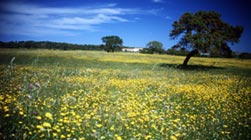 Luras’
inhabitants, unlike those of all the other towns in Gallura, keep on speaking
the original Sardinian language. There are a few hypotheses, which try
to give a possible and truthful interpretation to this singular peculiarity.
Around 1200, Gallura was infested by an awful epidemic. Only Luras preserved
its immunity, and it became the only one, which could repel the Corses
that, in the meantime, had occupied Northern Sardinia and conquered the
deserted villages they found on their way. This theory would justify the
preservation of the Sardinian language against the “Gallurese”
one, which has got an evident Corse derivation. Luras’
inhabitants, unlike those of all the other towns in Gallura, keep on speaking
the original Sardinian language. There are a few hypotheses, which try
to give a possible and truthful interpretation to this singular peculiarity.
Around 1200, Gallura was infested by an awful epidemic. Only Luras preserved
its immunity, and it became the only one, which could repel the Corses
that, in the meantime, had occupied Northern Sardinia and conquered the
deserted villages they found on their way. This theory would justify the
preservation of the Sardinian language against the “Gallurese”
one, which has got an evident Corse derivation.
The keeping of Sardinian language could be also due to the need of communicating
with people of interior Sardinia, during their trade wanderings.
The originality of “lurisincos”, as Luras’ inhabitants
are ethnically called, comes out right of their dialect, which, besides
the musicality of its accent, differs from the other North-Sardinian dialects
because of several other shades.
|
| |
The
archaeology
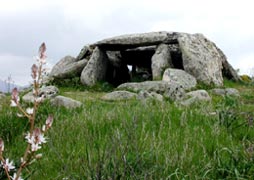 Luras’
people used to call them “Sepulturas de zigantes” or “de
paladinos”, whose translation could be “Tombs of Giants”,
but these important funerary megalithic monuments are known all over the
world as Dolmen. They represent a meaningful example of one of the greatest
concentrations of such kind of tombs. Luras’
people used to call them “Sepulturas de zigantes” or “de
paladinos”, whose translation could be “Tombs of Giants”,
but these important funerary megalithic monuments are known all over the
world as Dolmen. They represent a meaningful example of one of the greatest
concentrations of such kind of tombs.
Actually, in Luras’ territory there are even four: the “Allée
couverte” in Ladas and those with a plainer structure in Alzoledda,
Ciuledda and Billella.
The allée “Ladas”, whose covering is formed by two
big flat slabs, one of which turned out to be the second biggest one in
the whole Mediterranean basin, just like the other smaller dolmens, is
well preserved in its structure all made of local granite.
All together, they represent an interesting sequence of the evolution
of the building typology of these megalithic monuments, starting from
the simple dolmen of the Neolithic period, going through the realisation
of gallery tombs, such as the Allées couvertes, to get to the famous
“Tombe dei Giganti”.
|
| |
Then
thousand-year-old oleasters
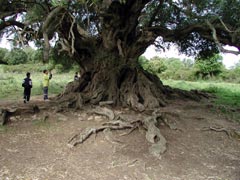 The
thousand-year-old oleasters of “Santu Baltolu” in Carana are
included in an enchanting natural landscape, on the shore of the Lake
Liscia, where the contrast between the granitic mountains and the lake
itself shows up some scenery of great value. The oldest of them, “s’ozzastru”,
as “luresi” (Luras’ inhabitants) affectionately but
respectfully use to call it, presents, at the height of 1,3 and up to
9,3 metres from the ground, a girth of about 12 metres. According to some
experts, it might be 3000-4000 years old, and therefore it would be one
of the oldest trees in Europe. The
thousand-year-old oleasters of “Santu Baltolu” in Carana are
included in an enchanting natural landscape, on the shore of the Lake
Liscia, where the contrast between the granitic mountains and the lake
itself shows up some scenery of great value. The oldest of them, “s’ozzastru”,
as “luresi” (Luras’ inhabitants) affectionately but
respectfully use to call it, presents, at the height of 1,3 and up to
9,3 metres from the ground, a girth of about 12 metres. According to some
experts, it might be 3000-4000 years old, and therefore it would be one
of the oldest trees in Europe.
This “patriarch of nature”, has been proclaimed Natural Monument
and by this time stands out the most important naturalistic guidebooks.
Moreover, it’s included today in the list of the “Twenty Age-old
Trees”, one for each Italian region, that must be safeguarded and
will be declared “National Monuments” by a ministerial decree.
|
| |
The
churches
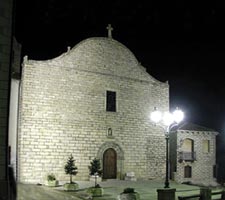 In
1765, by order of the Bishop of Civita, monsignor Pietro Paolo Carta,
the tumbled-down San Giacomo Church had been destroyed and, in its place,
a new parish church was built, consecrated to the Virgin Mary of the Rosary,
patroness of the village, and named therefore “Madonna del Rosario”.
It is an austere church in neo-Romanesque style, and, with its front-face
in rough granite, and the inside with a nave and two aisles, its arches
and the red bricks of the barrel-vaults, represents a precious specimen
of religious architecture in Gallura. Of great value the inner doors in
engraved wood, dated 1907, the marble baptistery of the 19th century,
the mannerist painting of the 17th century “Madonna with the Child”,
“The Whitsunday”(Pentecoste), painted by Antonio Caboni (1874),
and finally “The Purgatory”, painted in 1927 by Giovanni Patrone. In
1765, by order of the Bishop of Civita, monsignor Pietro Paolo Carta,
the tumbled-down San Giacomo Church had been destroyed and, in its place,
a new parish church was built, consecrated to the Virgin Mary of the Rosary,
patroness of the village, and named therefore “Madonna del Rosario”.
It is an austere church in neo-Romanesque style, and, with its front-face
in rough granite, and the inside with a nave and two aisles, its arches
and the red bricks of the barrel-vaults, represents a precious specimen
of religious architecture in Gallura. Of great value the inner doors in
engraved wood, dated 1907, the marble baptistery of the 19th century,
the mannerist painting of the 17th century “Madonna with the Child”,
“The Whitsunday”(Pentecoste), painted by Antonio Caboni (1874),
and finally “The Purgatory”, painted in 1927 by Giovanni Patrone.
In the neighbourhood of the parish, there’s Santa Croce, built in
the 18th century, as well as the parish. This little church has got a
front face in rough granite and it’s the chief-seat of the homonymous
Confraternity, which every year, at Christmas, attends to the realisation
of an absolutely valuable crib.
San Pietro is a classical little church that dates back to the Spanish
period of 17th century. And even the little church of “Purgatorio”,
built in the Savoyard period, at the end of 18th century, is worthy a
visit.
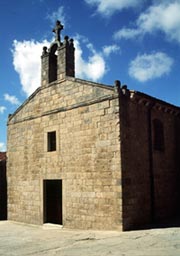 During the route that leads to visit these churches, you can have the
chance to walk through the old quarters of the historical centre, rich
in memories and antiquity, engraved on the granitic houses, whose walls
outline the narrow alleys, known as “sas carreras” and “sas
atterighinos”.
During the route that leads to visit these churches, you can have the
chance to walk through the old quarters of the historical centre, rich
in memories and antiquity, engraved on the granitic houses, whose walls
outline the narrow alleys, known as “sas carreras” and “sas
atterighinos”.
We can’t absolutely forget the large number of country churches,
surrounded by enchanting natural scenery and themselves examples of a
religious architecture, often considered very simple, but without doubt
rich in close and intimate devotion. The charming “Santa Maria delle
Grazie” was certainly part of the medieval village Siffilionis.
Not far from it, another church rises, San Pietro, the old parish of this
village, unfortunately crumbling nowadays and awaiting restoration works.
Just above the other two, lies San Leonardo, built in 19th century probably
upon the ruins of a pre-existent church. “San Bartolomeo”
lies on a hill in Carana,
that looks down Liscia Lake, in close proximity of the millenary oleasters.
This church is without doubt rather ancient, even if dating it with certainty
is hardly impossible; it’s been almost entirely rebuilt in the early
sixties, just after the construction of the dike on Liscia Lake had flooded
the ancient “San Nicola” church.
San Michele in Canaili is a very ancient church too and can most likely
be regarded as the parish of the extinct medieval village Canahini.
|
| |
 The previous news items are drawn from the booklet made by the tourist association
“Pro Loco” and by “Comune di Luras”
The previous news items are drawn from the booklet made by the tourist association
“Pro Loco” and by “Comune di Luras” |
| |
The
Sardinian crib
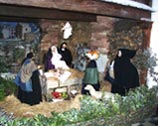 The
tourists who visit this little town at Christmas have the opportunity
of admiring the traditional crib, set up in Santa Croce, supervised by
the prior of the homonymous confraternity, Pier Paolo Cabras, who revives
every year with his confrères’ help, a picturesque frame
of the country life of many years ago. Nativity always takes place in
some scenery, with our village as a background, rebuilding with a determinate
accuracy several Luras’ characteristic views. Skill joined to fancy,
makes the subject change at every Christmas, always thoroughly respecting
the most rooted traditions. And for this reason, it’s become a fixed
yearly appointment for our village. The Infant Jesus, the Virgin Mary
and St. Joseph, as well as the shepherds, wear traditional local costumes. The
tourists who visit this little town at Christmas have the opportunity
of admiring the traditional crib, set up in Santa Croce, supervised by
the prior of the homonymous confraternity, Pier Paolo Cabras, who revives
every year with his confrères’ help, a picturesque frame
of the country life of many years ago. Nativity always takes place in
some scenery, with our village as a background, rebuilding with a determinate
accuracy several Luras’ characteristic views. Skill joined to fancy,
makes the subject change at every Christmas, always thoroughly respecting
the most rooted traditions. And for this reason, it’s become a fixed
yearly appointment for our village. The Infant Jesus, the Virgin Mary
and St. Joseph, as well as the shepherds, wear traditional local costumes.
  Go
to cribs's pictures
Go
to cribs's pictures
Home
The
author The
works The
works The
collection The
collection The
techniques The
techniques Cork Cork The
newspapers The
newspapers Guest
Book Guest
Book |
